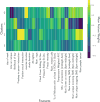Personalized Multitask Learning for Predicting Tomorrow's Mood, Stress, and Health
- PMID: 32489521
- PMCID: PMC7266106
- DOI: 10.1109/TAFFC.2017.2784832
Personalized Multitask Learning for Predicting Tomorrow's Mood, Stress, and Health
Abstract
While accurately predicting mood and wellbeing could have a number of important clinical benefits, traditional machine learning (ML) methods frequently yield low performance in this domain. We posit that this is because a one-size-fits-all machine learning model is inherently ill-suited to predicting outcomes like mood and stress, which vary greatly due to individual differences. Therefore, we employ Multitask Learning (MTL) techniques to train personalized ML models which are customized to the needs of each individual, but still leverage data from across the population. Three formulations of MTL are compared: i) MTL deep neural networks, which share several hidden layers but have final layers unique to each task; ii) Multi-task Multi-Kernel learning, which feeds information across tasks through kernel weights on feature types; and iii) a Hierarchical Bayesian model in which tasks share a common Dirichlet Process prior. We offer the code for this work in open source. These techniques are investigated in the context of predicting future mood, stress, and health using data collected from surveys, wearable sensors, smartphone logs, and the weather. Empirical results demonstrate that using MTL to account for individual differences provides large performance improvements over traditional machine learning methods and provides personalized, actionable insights.
Keywords: Deep Neural Networks; Hierarchical Bayesian Model; Mood Prediction; Multi-Kernel SVM; Multitask learning.
Figures













References
-
- Cheng H, Furnham A. Personality, self-esteem, and demographic predictions of happiness and depression. Personality and individual differences. 2003;34(6):921–942.
-
- Veenhoven R. Healthy happiness: Effects of happiness on physical health and the consequences for preventive health care. Journal of happiness studies. 2008;9(3):449–469.
-
- Cohen S, et al. Psychological stress and susceptibility to the common cold. New England journal of medicine. 1991;325(9):606–612. - PubMed
-
- Aichele S, Rabbitt P, Ghisletta P. Think fast, feel fine, live long: A 29-year study of cognition, health, and survival in middle-aged and older adults. Psychological science. 2016;27(4):518–529. - PubMed
Grants and funding
LinkOut - more resources
Full Text Sources
Other Literature Sources
